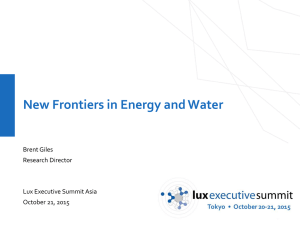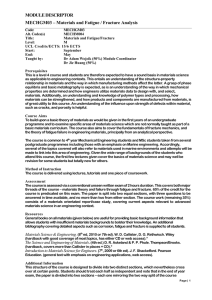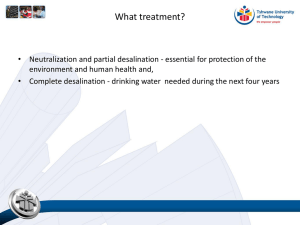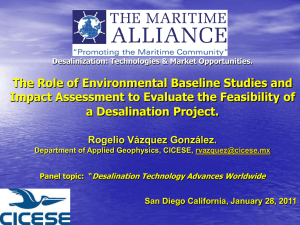RiceWERC Li short
advertisement
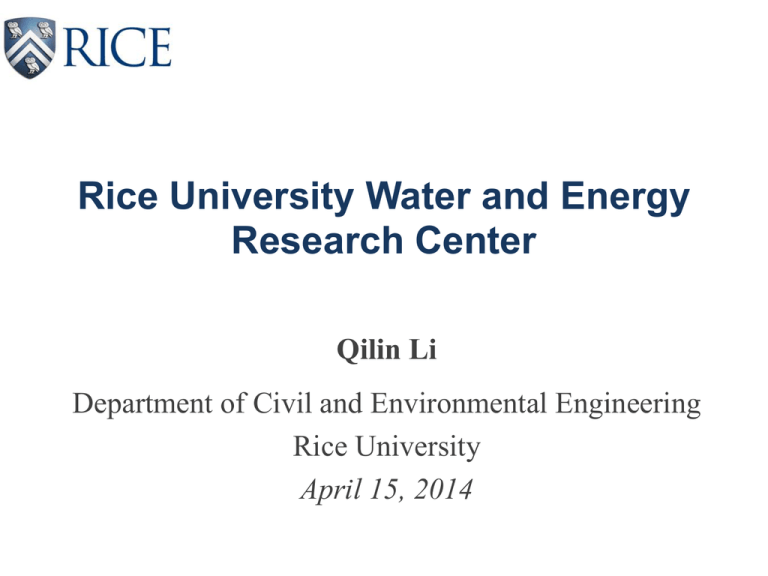
Rice University Water and Energy Research Center Qilin Li Department of Civil and Environmental Engineering Rice University April 15, 2014 World Energy Consumption http://ourfiniteworld.com/2012/03/12/ Importance of Water for Energy Residual Additives Heavy Metals Scaling ions Organics Salts • Water is the largest byproduct of the fossil fuel industry • Unconventional O&G and biofuel production requires large quantities of water Water/Oil Ratio = 10 (US), 14 (Can.) $1 trillion/yr challenge* 50 gallons of water per mile driven on ethanol *http://www.twdb.state.tx.us/Desalination/TheFutureofDesalinationinTexas-Volume2/documents/B3.pdf Global Water Crisis Stressors: • Population growth • Climate change • Contamination Source: International Water Management Institute, 2006, Comprehensive Assessment of Water Management in Agriculture Hydraulic Fracturing Water Use Bakken1: 15000 m3/fracture Niobrara2: 12500 m3/fracture Marcellus2: 22000 m3/fracture Barnett2: 18500 m3/fracture Eagle Ford2: 22000 m3/fracture Haynesville2: 22000 m3/fracture 1: National Energy Technology Laboratory Winter 2011 Newsletter 2: EPA Hydraulic Fracturing Study Technical Workshop #4: Water Resource Management, March 2011 All-llc.com Current Drought Condition in the U.S. Energy for Water Production Other Related, 10% Maintenance, Legal/Permitting, 6% 2% Labor, 6% Chemicals, 6% Waste Dsiposal, 4% Cartridge Filters and RO Membrane Replacements, 11% Power (Energy), 55% Desalination Operation and Maintenance Cost 20% of energy use in cities is for moving water1 Desalination and wastewater reuse is energy intensive 2 1. Electric Power Research Institute, Inc. Water & Sustainability (Volume 4): U.S. Electricity Consumption for Water Supply & Treatment – The Next Half Century. 2002. 2. Water Reuse Association, Seawater desalination cost, January 2012 Vision Policy Life Cycle Perspective Integrated Water Management Technology Nano Bio Adv. Mat. Mission • Establish an ecosystem of innovation in partnership with the energy and water industries as well as municipalities to: – Enhance the sustainable and efficient use (and reuse) of water resources in energy production – Reduce the economic and environmental costs of the water footprint – Alleviate water-related impairment (e.g., souring, corrosion, flooding) – Increase energy efficiency, safety and reliability of urban water supply RiceWERC Faculty Pulickel Ajayan Nanomaterials for water and energy Pedro J. Alvarez Microbial control bioremediation, WFP Andrea Ballestero Water law, economics and techno-science Phil Bedient Urban hydrology & flood protection George Bennett Microbiology and biotechnology Leonardo Duenas-Osorio Complex systems Vicki Colvin Nano-bio/environ interactions Naomi Halas Nanophotonics for disinfection George Hirasaki Interfacial phenomena, enhanced oil recovery Qilin Li Advanced water treatment Jun Lou Peter Nordlander Mateo Pasquali Mason Tomson Nano fab. for Nano photonics Fluid mechanics and Brine chemistry, Energy&environ. nano-structures scale prevention James Tour Nano for water treatment Mike Wong Catalysts for water treatment Bioremediation Catalysis Refining Beneficial reuse Disposal Transportation and storage Treated wastewater Feedstock Cooling water Resource recovery Desalination Softening Organic removal Membrane fouling control Refinery wastewater Brine Chemistry Water-mineral interactions Corrosion control EOR Flow Assurance NP transport Produced water Formation water Exploration & extraction Polluted water & soil Microbial control Scale inhibition Injection water Integrated Water Management Key Challenges Best Addressed by Academicindustrial Partnerships • Inefficient development of reserves (e.g., reservoir souring, and low O&G recovery) • Safety and operational issues (H2S, corrosion, scaling) • Increasing costs of water acquisition, treatment and disposal • Regulatory constraints and uncertainty • Beneficial disposition of produced waters • Public mistrust NSF Nanosystems Engineering Research Center for Off-Grid Nanotechnology Enabled Water Treatment (NEWT) Goal: Mobile, compact, modular, solar powered systems for O&G produced water treatment and drinking water supply Team: Rice University, Arizona State University, Yale University, University of Texas at El Paso Invitation to Join WERC and NEWT


